Hospital Care Quality Enhancement Factors
VerifiedAdded on 2020/04/21
|9
|1947
|46
AI Summary
This assignment explores various factors contributing to the enhancement or decline of quality in hospital care services. It delves into the significance of effective communication, examines the impact of nurses' job satisfaction on care quality, and highlights the role of interprofessional teams in improving patient outcomes. The use of the SIBR model for gathering information about influencing factors is also discussed. The document concludes by summarizing the key findings and their implications for enhancing hospital care.
Contribute Materials
Your contribution can guide someone’s learning journey. Share your
documents today.
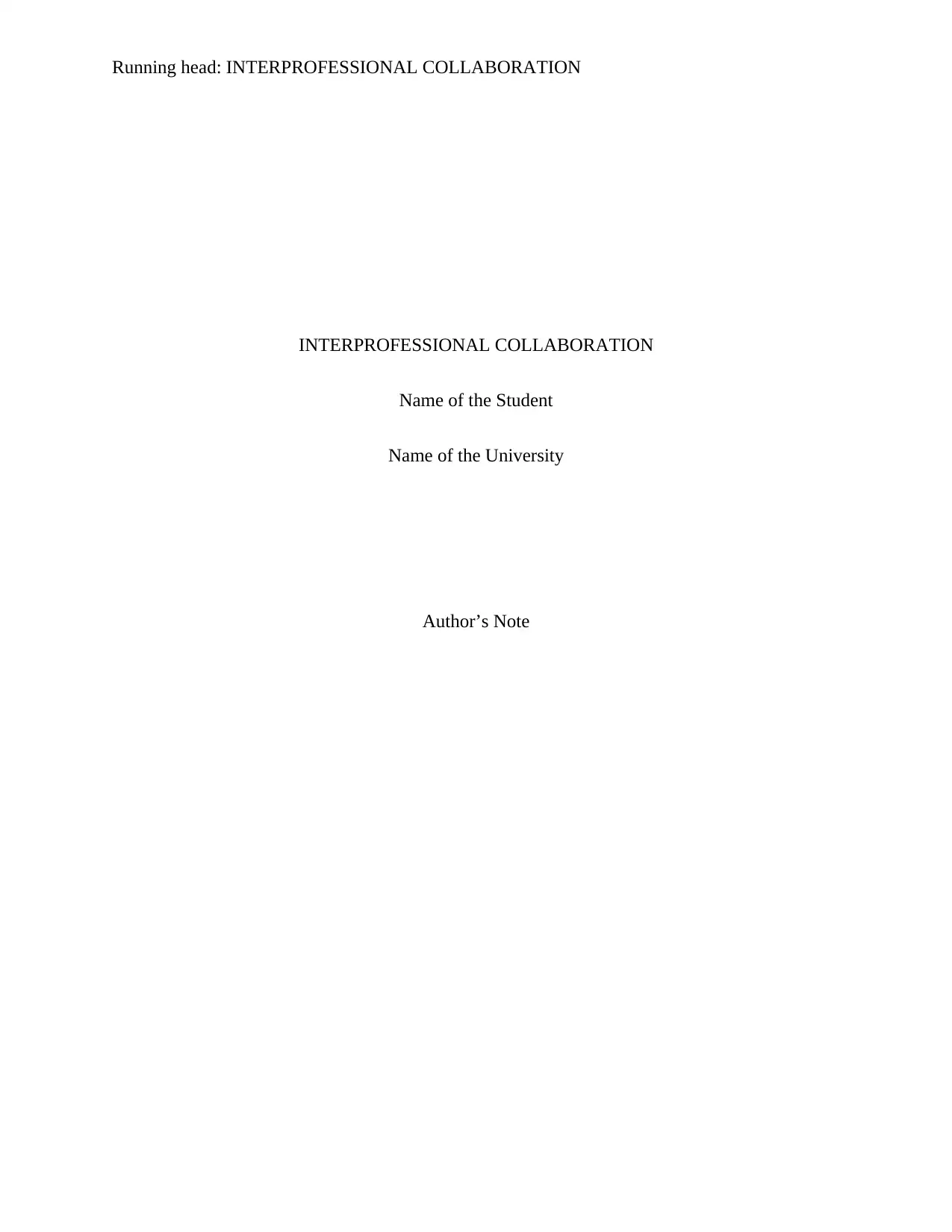
Running head: INTERPROFESSIONAL COLLABORATION
INTERPROFESSIONAL COLLABORATION
Name of the Student
Name of the University
Author’s Note
INTERPROFESSIONAL COLLABORATION
Name of the Student
Name of the University
Author’s Note
Secure Best Marks with AI Grader
Need help grading? Try our AI Grader for instant feedback on your assignments.
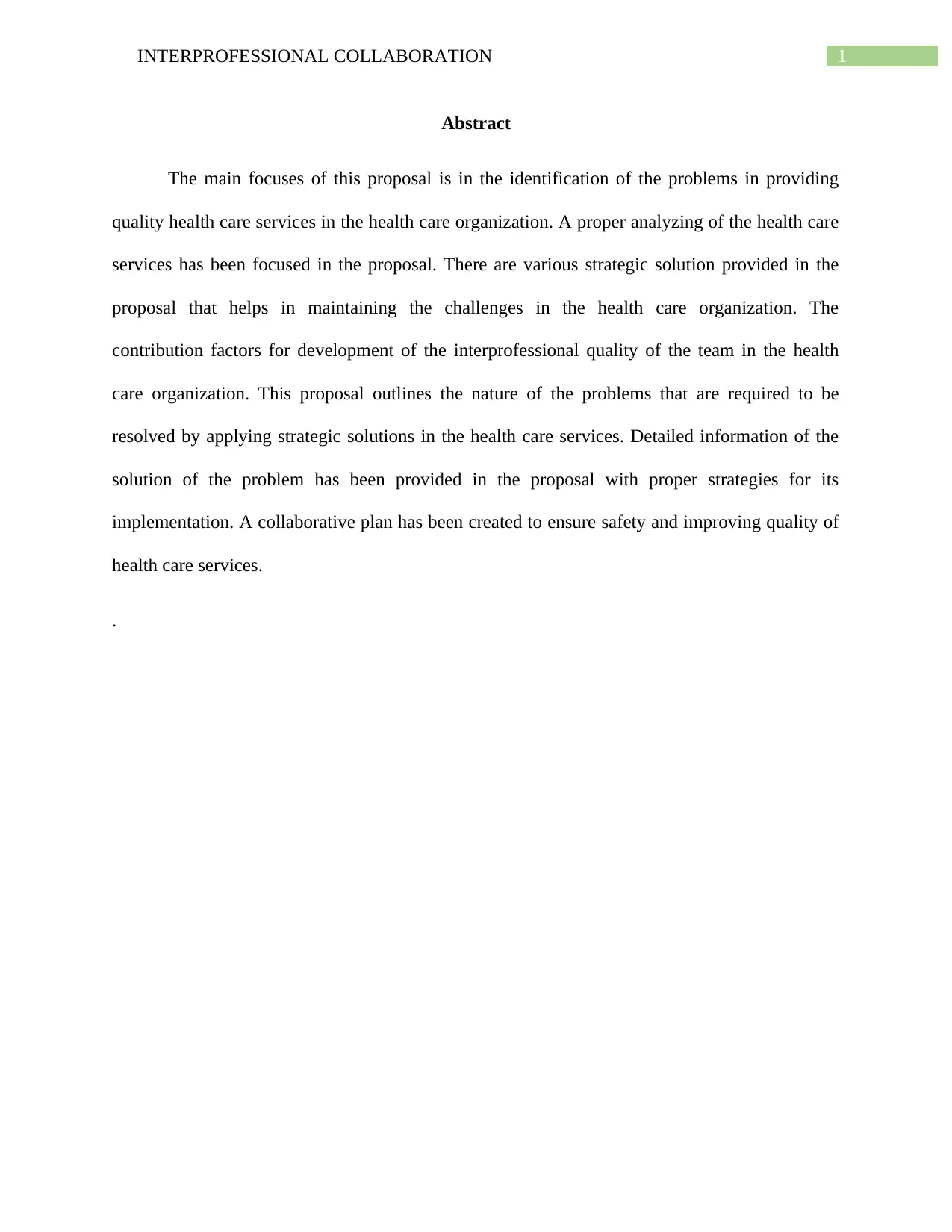
1INTERPROFESSIONAL COLLABORATION
Abstract
The main focuses of this proposal is in the identification of the problems in providing
quality health care services in the health care organization. A proper analyzing of the health care
services has been focused in the proposal. There are various strategic solution provided in the
proposal that helps in maintaining the challenges in the health care organization. The
contribution factors for development of the interprofessional quality of the team in the health
care organization. This proposal outlines the nature of the problems that are required to be
resolved by applying strategic solutions in the health care services. Detailed information of the
solution of the problem has been provided in the proposal with proper strategies for its
implementation. A collaborative plan has been created to ensure safety and improving quality of
health care services.
.
Abstract
The main focuses of this proposal is in the identification of the problems in providing
quality health care services in the health care organization. A proper analyzing of the health care
services has been focused in the proposal. There are various strategic solution provided in the
proposal that helps in maintaining the challenges in the health care organization. The
contribution factors for development of the interprofessional quality of the team in the health
care organization. This proposal outlines the nature of the problems that are required to be
resolved by applying strategic solutions in the health care services. Detailed information of the
solution of the problem has been provided in the proposal with proper strategies for its
implementation. A collaborative plan has been created to ensure safety and improving quality of
health care services.
.
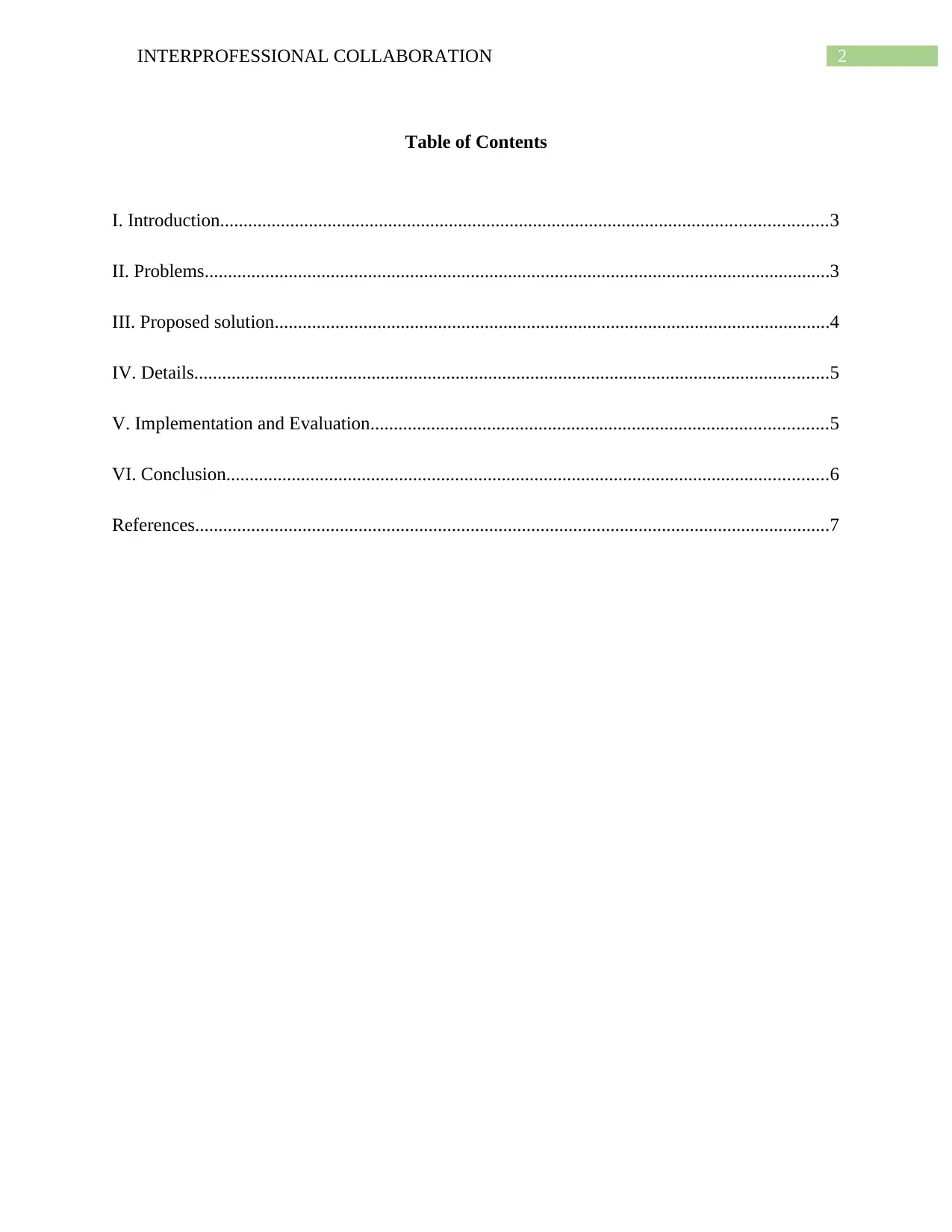
2INTERPROFESSIONAL COLLABORATION
Table of Contents
I. Introduction..................................................................................................................................3
II. Problems......................................................................................................................................3
III. Proposed solution.......................................................................................................................4
IV. Details........................................................................................................................................5
V. Implementation and Evaluation..................................................................................................5
VI. Conclusion.................................................................................................................................6
References........................................................................................................................................7
Table of Contents
I. Introduction..................................................................................................................................3
II. Problems......................................................................................................................................3
III. Proposed solution.......................................................................................................................4
IV. Details........................................................................................................................................5
V. Implementation and Evaluation..................................................................................................5
VI. Conclusion.................................................................................................................................6
References........................................................................................................................................7
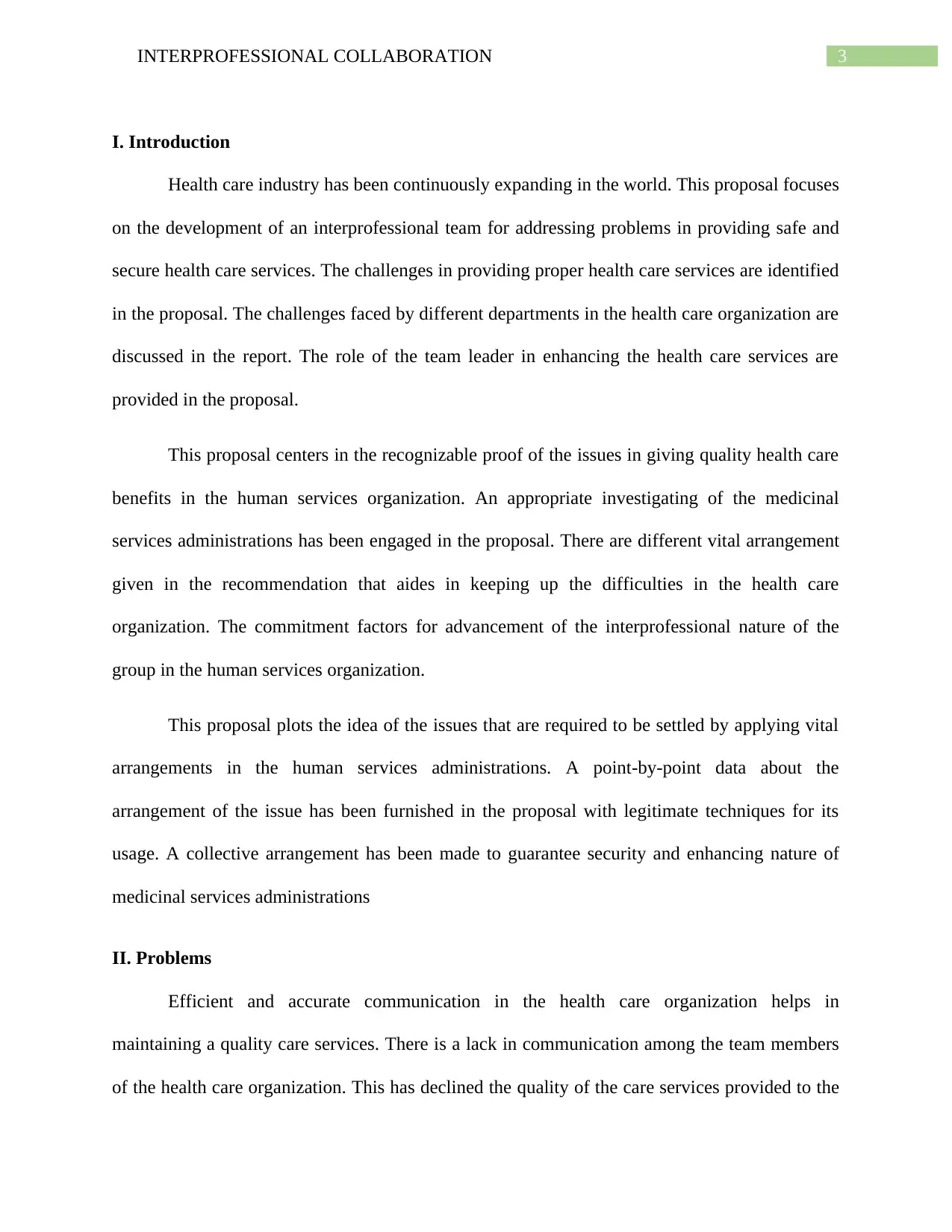
3INTERPROFESSIONAL COLLABORATION
I. Introduction
Health care industry has been continuously expanding in the world. This proposal focuses
on the development of an interprofessional team for addressing problems in providing safe and
secure health care services. The challenges in providing proper health care services are identified
in the proposal. The challenges faced by different departments in the health care organization are
discussed in the report. The role of the team leader in enhancing the health care services are
provided in the proposal.
This proposal centers in the recognizable proof of the issues in giving quality health care
benefits in the human services organization. An appropriate investigating of the medicinal
services administrations has been engaged in the proposal. There are different vital arrangement
given in the recommendation that aides in keeping up the difficulties in the health care
organization. The commitment factors for advancement of the interprofessional nature of the
group in the human services organization.
This proposal plots the idea of the issues that are required to be settled by applying vital
arrangements in the human services administrations. A point-by-point data about the
arrangement of the issue has been furnished in the proposal with legitimate techniques for its
usage. A collective arrangement has been made to guarantee security and enhancing nature of
medicinal services administrations
II. Problems
Efficient and accurate communication in the health care organization helps in
maintaining a quality care services. There is a lack in communication among the team members
of the health care organization. This has declined the quality of the care services provided to the
I. Introduction
Health care industry has been continuously expanding in the world. This proposal focuses
on the development of an interprofessional team for addressing problems in providing safe and
secure health care services. The challenges in providing proper health care services are identified
in the proposal. The challenges faced by different departments in the health care organization are
discussed in the report. The role of the team leader in enhancing the health care services are
provided in the proposal.
This proposal centers in the recognizable proof of the issues in giving quality health care
benefits in the human services organization. An appropriate investigating of the medicinal
services administrations has been engaged in the proposal. There are different vital arrangement
given in the recommendation that aides in keeping up the difficulties in the health care
organization. The commitment factors for advancement of the interprofessional nature of the
group in the human services organization.
This proposal plots the idea of the issues that are required to be settled by applying vital
arrangements in the human services administrations. A point-by-point data about the
arrangement of the issue has been furnished in the proposal with legitimate techniques for its
usage. A collective arrangement has been made to guarantee security and enhancing nature of
medicinal services administrations
II. Problems
Efficient and accurate communication in the health care organization helps in
maintaining a quality care services. There is a lack in communication among the team members
of the health care organization. This has declined the quality of the care services provided to the
Secure Best Marks with AI Grader
Need help grading? Try our AI Grader for instant feedback on your assignments.
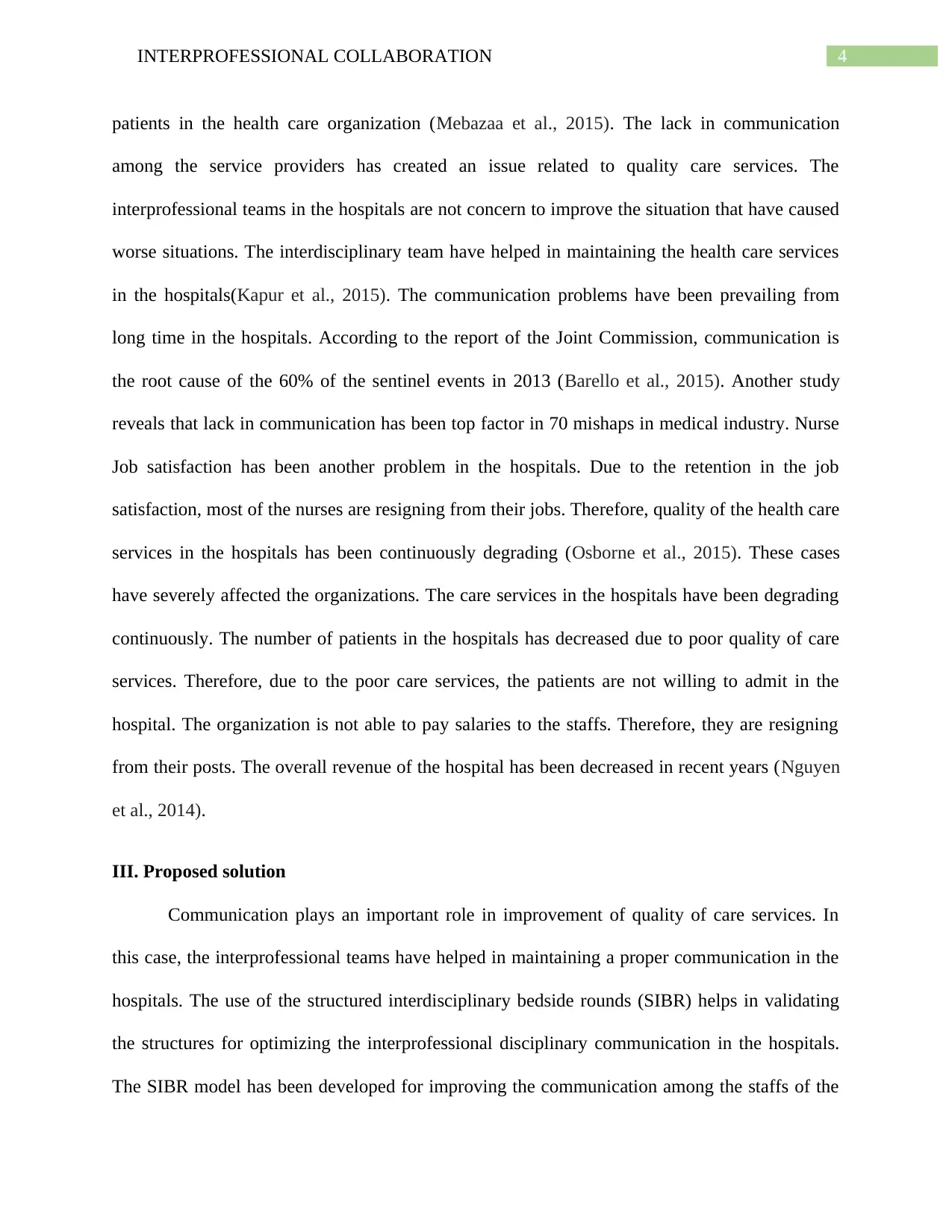
4INTERPROFESSIONAL COLLABORATION
patients in the health care organization (Mebazaa et al., 2015). The lack in communication
among the service providers has created an issue related to quality care services. The
interprofessional teams in the hospitals are not concern to improve the situation that have caused
worse situations. The interdisciplinary team have helped in maintaining the health care services
in the hospitals(Kapur et al., 2015). The communication problems have been prevailing from
long time in the hospitals. According to the report of the Joint Commission, communication is
the root cause of the 60% of the sentinel events in 2013 (Barello et al., 2015). Another study
reveals that lack in communication has been top factor in 70 mishaps in medical industry. Nurse
Job satisfaction has been another problem in the hospitals. Due to the retention in the job
satisfaction, most of the nurses are resigning from their jobs. Therefore, quality of the health care
services in the hospitals has been continuously degrading (Osborne et al., 2015). These cases
have severely affected the organizations. The care services in the hospitals have been degrading
continuously. The number of patients in the hospitals has decreased due to poor quality of care
services. Therefore, due to the poor care services, the patients are not willing to admit in the
hospital. The organization is not able to pay salaries to the staffs. Therefore, they are resigning
from their posts. The overall revenue of the hospital has been decreased in recent years (Nguyen
et al., 2014).
III. Proposed solution
Communication plays an important role in improvement of quality of care services. In
this case, the interprofessional teams have helped in maintaining a proper communication in the
hospitals. The use of the structured interdisciplinary bedside rounds (SIBR) helps in validating
the structures for optimizing the interprofessional disciplinary communication in the hospitals.
The SIBR model has been developed for improving the communication among the staffs of the
patients in the health care organization (Mebazaa et al., 2015). The lack in communication
among the service providers has created an issue related to quality care services. The
interprofessional teams in the hospitals are not concern to improve the situation that have caused
worse situations. The interdisciplinary team have helped in maintaining the health care services
in the hospitals(Kapur et al., 2015). The communication problems have been prevailing from
long time in the hospitals. According to the report of the Joint Commission, communication is
the root cause of the 60% of the sentinel events in 2013 (Barello et al., 2015). Another study
reveals that lack in communication has been top factor in 70 mishaps in medical industry. Nurse
Job satisfaction has been another problem in the hospitals. Due to the retention in the job
satisfaction, most of the nurses are resigning from their jobs. Therefore, quality of the health care
services in the hospitals has been continuously degrading (Osborne et al., 2015). These cases
have severely affected the organizations. The care services in the hospitals have been degrading
continuously. The number of patients in the hospitals has decreased due to poor quality of care
services. Therefore, due to the poor care services, the patients are not willing to admit in the
hospital. The organization is not able to pay salaries to the staffs. Therefore, they are resigning
from their posts. The overall revenue of the hospital has been decreased in recent years (Nguyen
et al., 2014).
III. Proposed solution
Communication plays an important role in improvement of quality of care services. In
this case, the interprofessional teams have helped in maintaining a proper communication in the
hospitals. The use of the structured interdisciplinary bedside rounds (SIBR) helps in validating
the structures for optimizing the interprofessional disciplinary communication in the hospitals.
The SIBR model has been developed for improving the communication among the staffs of the
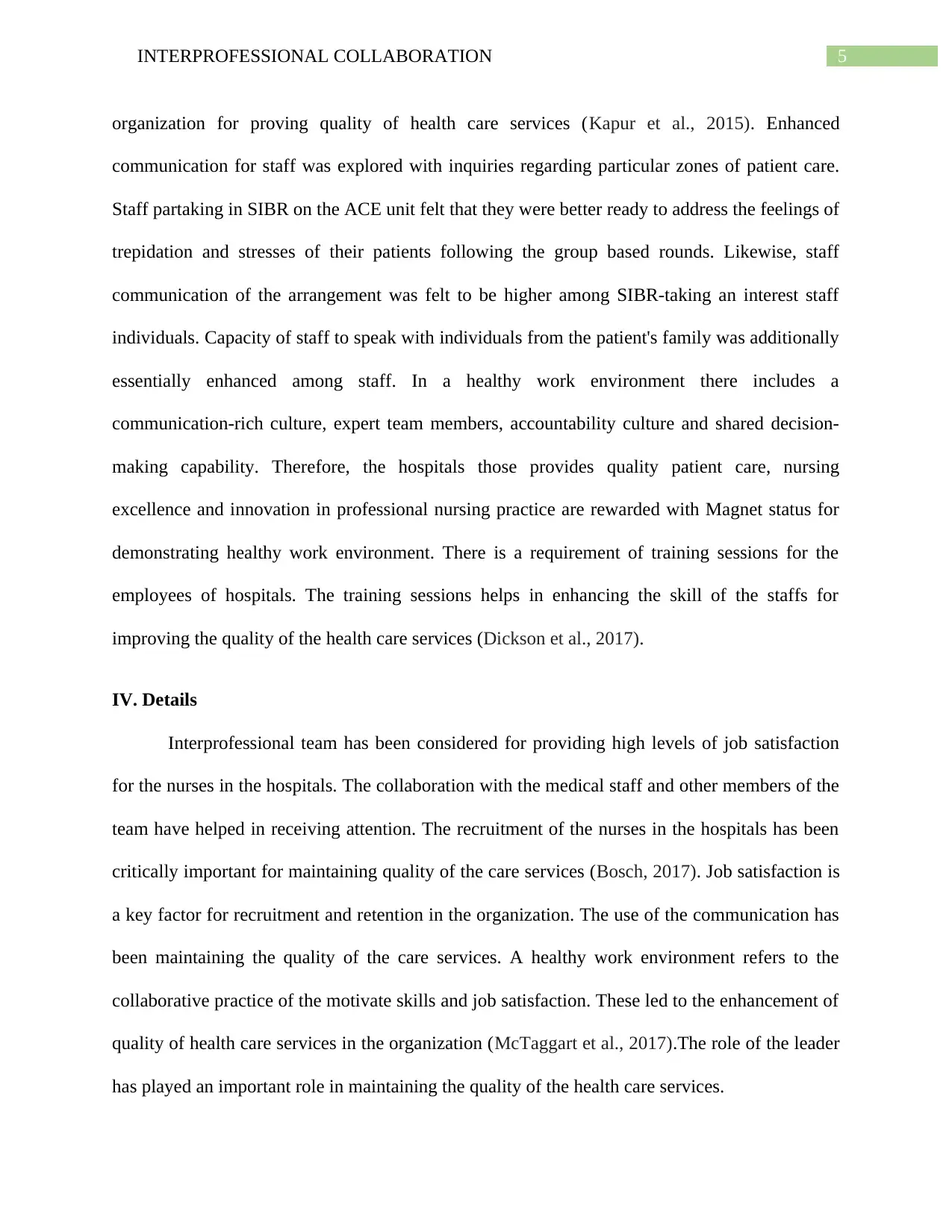
5INTERPROFESSIONAL COLLABORATION
organization for proving quality of health care services (Kapur et al., 2015). Enhanced
communication for staff was explored with inquiries regarding particular zones of patient care.
Staff partaking in SIBR on the ACE unit felt that they were better ready to address the feelings of
trepidation and stresses of their patients following the group based rounds. Likewise, staff
communication of the arrangement was felt to be higher among SIBR-taking an interest staff
individuals. Capacity of staff to speak with individuals from the patient's family was additionally
essentially enhanced among staff. In a healthy work environment there includes a
communication-rich culture, expert team members, accountability culture and shared decision-
making capability. Therefore, the hospitals those provides quality patient care, nursing
excellence and innovation in professional nursing practice are rewarded with Magnet status for
demonstrating healthy work environment. There is a requirement of training sessions for the
employees of hospitals. The training sessions helps in enhancing the skill of the staffs for
improving the quality of the health care services (Dickson et al., 2017).
IV. Details
Interprofessional team has been considered for providing high levels of job satisfaction
for the nurses in the hospitals. The collaboration with the medical staff and other members of the
team have helped in receiving attention. The recruitment of the nurses in the hospitals has been
critically important for maintaining quality of the care services (Bosch, 2017). Job satisfaction is
a key factor for recruitment and retention in the organization. The use of the communication has
been maintaining the quality of the care services. A healthy work environment refers to the
collaborative practice of the motivate skills and job satisfaction. These led to the enhancement of
quality of health care services in the organization (McTaggart et al., 2017).The role of the leader
has played an important role in maintaining the quality of the health care services.
organization for proving quality of health care services (Kapur et al., 2015). Enhanced
communication for staff was explored with inquiries regarding particular zones of patient care.
Staff partaking in SIBR on the ACE unit felt that they were better ready to address the feelings of
trepidation and stresses of their patients following the group based rounds. Likewise, staff
communication of the arrangement was felt to be higher among SIBR-taking an interest staff
individuals. Capacity of staff to speak with individuals from the patient's family was additionally
essentially enhanced among staff. In a healthy work environment there includes a
communication-rich culture, expert team members, accountability culture and shared decision-
making capability. Therefore, the hospitals those provides quality patient care, nursing
excellence and innovation in professional nursing practice are rewarded with Magnet status for
demonstrating healthy work environment. There is a requirement of training sessions for the
employees of hospitals. The training sessions helps in enhancing the skill of the staffs for
improving the quality of the health care services (Dickson et al., 2017).
IV. Details
Interprofessional team has been considered for providing high levels of job satisfaction
for the nurses in the hospitals. The collaboration with the medical staff and other members of the
team have helped in receiving attention. The recruitment of the nurses in the hospitals has been
critically important for maintaining quality of the care services (Bosch, 2017). Job satisfaction is
a key factor for recruitment and retention in the organization. The use of the communication has
been maintaining the quality of the care services. A healthy work environment refers to the
collaborative practice of the motivate skills and job satisfaction. These led to the enhancement of
quality of health care services in the organization (McTaggart et al., 2017).The role of the leader
has played an important role in maintaining the quality of the health care services.
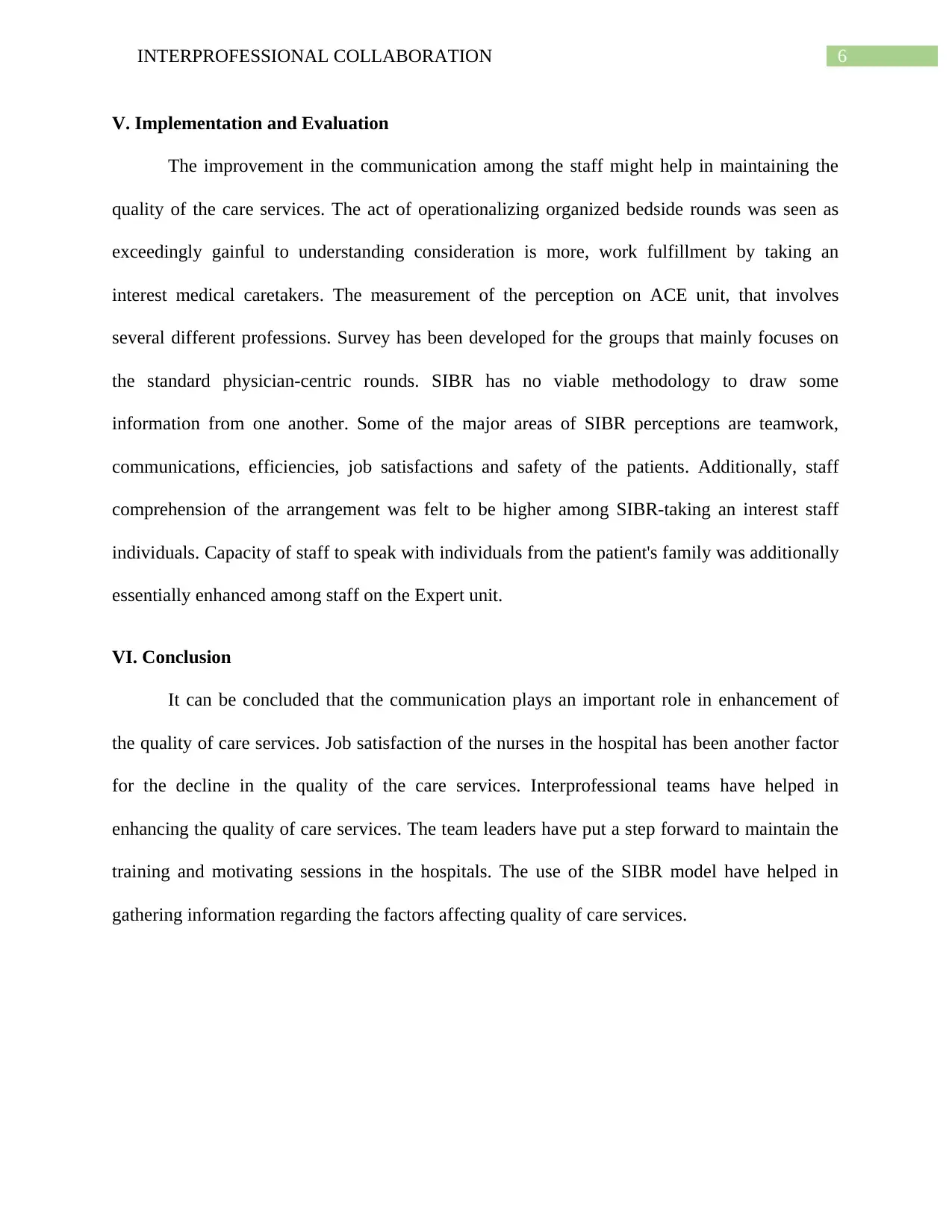
6INTERPROFESSIONAL COLLABORATION
V. Implementation and Evaluation
The improvement in the communication among the staff might help in maintaining the
quality of the care services. The act of operationalizing organized bedside rounds was seen as
exceedingly gainful to understanding consideration is more, work fulfillment by taking an
interest medical caretakers. The measurement of the perception on ACE unit, that involves
several different professions. Survey has been developed for the groups that mainly focuses on
the standard physician-centric rounds. SIBR has no viable methodology to draw some
information from one another. Some of the major areas of SIBR perceptions are teamwork,
communications, efficiencies, job satisfactions and safety of the patients. Additionally, staff
comprehension of the arrangement was felt to be higher among SIBR-taking an interest staff
individuals. Capacity of staff to speak with individuals from the patient's family was additionally
essentially enhanced among staff on the Expert unit.
VI. Conclusion
It can be concluded that the communication plays an important role in enhancement of
the quality of care services. Job satisfaction of the nurses in the hospital has been another factor
for the decline in the quality of the care services. Interprofessional teams have helped in
enhancing the quality of care services. The team leaders have put a step forward to maintain the
training and motivating sessions in the hospitals. The use of the SIBR model have helped in
gathering information regarding the factors affecting quality of care services.
V. Implementation and Evaluation
The improvement in the communication among the staff might help in maintaining the
quality of the care services. The act of operationalizing organized bedside rounds was seen as
exceedingly gainful to understanding consideration is more, work fulfillment by taking an
interest medical caretakers. The measurement of the perception on ACE unit, that involves
several different professions. Survey has been developed for the groups that mainly focuses on
the standard physician-centric rounds. SIBR has no viable methodology to draw some
information from one another. Some of the major areas of SIBR perceptions are teamwork,
communications, efficiencies, job satisfactions and safety of the patients. Additionally, staff
comprehension of the arrangement was felt to be higher among SIBR-taking an interest staff
individuals. Capacity of staff to speak with individuals from the patient's family was additionally
essentially enhanced among staff on the Expert unit.
VI. Conclusion
It can be concluded that the communication plays an important role in enhancement of
the quality of care services. Job satisfaction of the nurses in the hospital has been another factor
for the decline in the quality of the care services. Interprofessional teams have helped in
enhancing the quality of care services. The team leaders have put a step forward to maintain the
training and motivating sessions in the hospitals. The use of the SIBR model have helped in
gathering information regarding the factors affecting quality of care services.
Paraphrase This Document
Need a fresh take? Get an instant paraphrase of this document with our AI Paraphraser
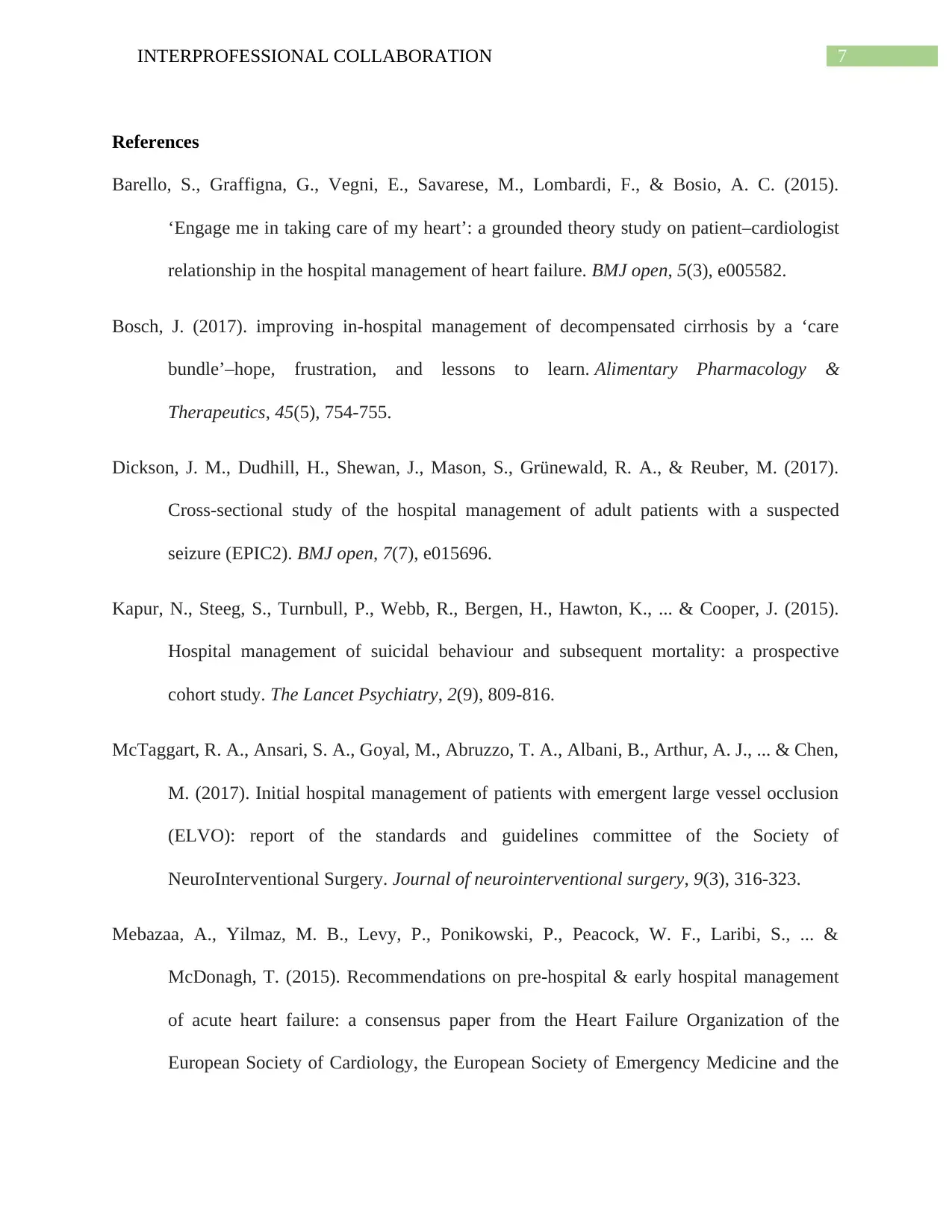
7INTERPROFESSIONAL COLLABORATION
References
Barello, S., Graffigna, G., Vegni, E., Savarese, M., Lombardi, F., & Bosio, A. C. (2015).
‘Engage me in taking care of my heart’: a grounded theory study on patient–cardiologist
relationship in the hospital management of heart failure. BMJ open, 5(3), e005582.
Bosch, J. (2017). improving in‐hospital management of decompensated cirrhosis by a ‘care
bundle’–hope, frustration, and lessons to learn. Alimentary Pharmacology &
Therapeutics, 45(5), 754-755.
Dickson, J. M., Dudhill, H., Shewan, J., Mason, S., Grünewald, R. A., & Reuber, M. (2017).
Cross-sectional study of the hospital management of adult patients with a suspected
seizure (EPIC2). BMJ open, 7(7), e015696.
Kapur, N., Steeg, S., Turnbull, P., Webb, R., Bergen, H., Hawton, K., ... & Cooper, J. (2015).
Hospital management of suicidal behaviour and subsequent mortality: a prospective
cohort study. The Lancet Psychiatry, 2(9), 809-816.
McTaggart, R. A., Ansari, S. A., Goyal, M., Abruzzo, T. A., Albani, B., Arthur, A. J., ... & Chen,
M. (2017). Initial hospital management of patients with emergent large vessel occlusion
(ELVO): report of the standards and guidelines committee of the Society of
NeuroInterventional Surgery. Journal of neurointerventional surgery, 9(3), 316-323.
Mebazaa, A., Yilmaz, M. B., Levy, P., Ponikowski, P., Peacock, W. F., Laribi, S., ... &
McDonagh, T. (2015). Recommendations on pre‐hospital & early hospital management
of acute heart failure: a consensus paper from the Heart Failure Organization of the
European Society of Cardiology, the European Society of Emergency Medicine and the
References
Barello, S., Graffigna, G., Vegni, E., Savarese, M., Lombardi, F., & Bosio, A. C. (2015).
‘Engage me in taking care of my heart’: a grounded theory study on patient–cardiologist
relationship in the hospital management of heart failure. BMJ open, 5(3), e005582.
Bosch, J. (2017). improving in‐hospital management of decompensated cirrhosis by a ‘care
bundle’–hope, frustration, and lessons to learn. Alimentary Pharmacology &
Therapeutics, 45(5), 754-755.
Dickson, J. M., Dudhill, H., Shewan, J., Mason, S., Grünewald, R. A., & Reuber, M. (2017).
Cross-sectional study of the hospital management of adult patients with a suspected
seizure (EPIC2). BMJ open, 7(7), e015696.
Kapur, N., Steeg, S., Turnbull, P., Webb, R., Bergen, H., Hawton, K., ... & Cooper, J. (2015).
Hospital management of suicidal behaviour and subsequent mortality: a prospective
cohort study. The Lancet Psychiatry, 2(9), 809-816.
McTaggart, R. A., Ansari, S. A., Goyal, M., Abruzzo, T. A., Albani, B., Arthur, A. J., ... & Chen,
M. (2017). Initial hospital management of patients with emergent large vessel occlusion
(ELVO): report of the standards and guidelines committee of the Society of
NeuroInterventional Surgery. Journal of neurointerventional surgery, 9(3), 316-323.
Mebazaa, A., Yilmaz, M. B., Levy, P., Ponikowski, P., Peacock, W. F., Laribi, S., ... &
McDonagh, T. (2015). Recommendations on pre‐hospital & early hospital management
of acute heart failure: a consensus paper from the Heart Failure Organization of the
European Society of Cardiology, the European Society of Emergency Medicine and the
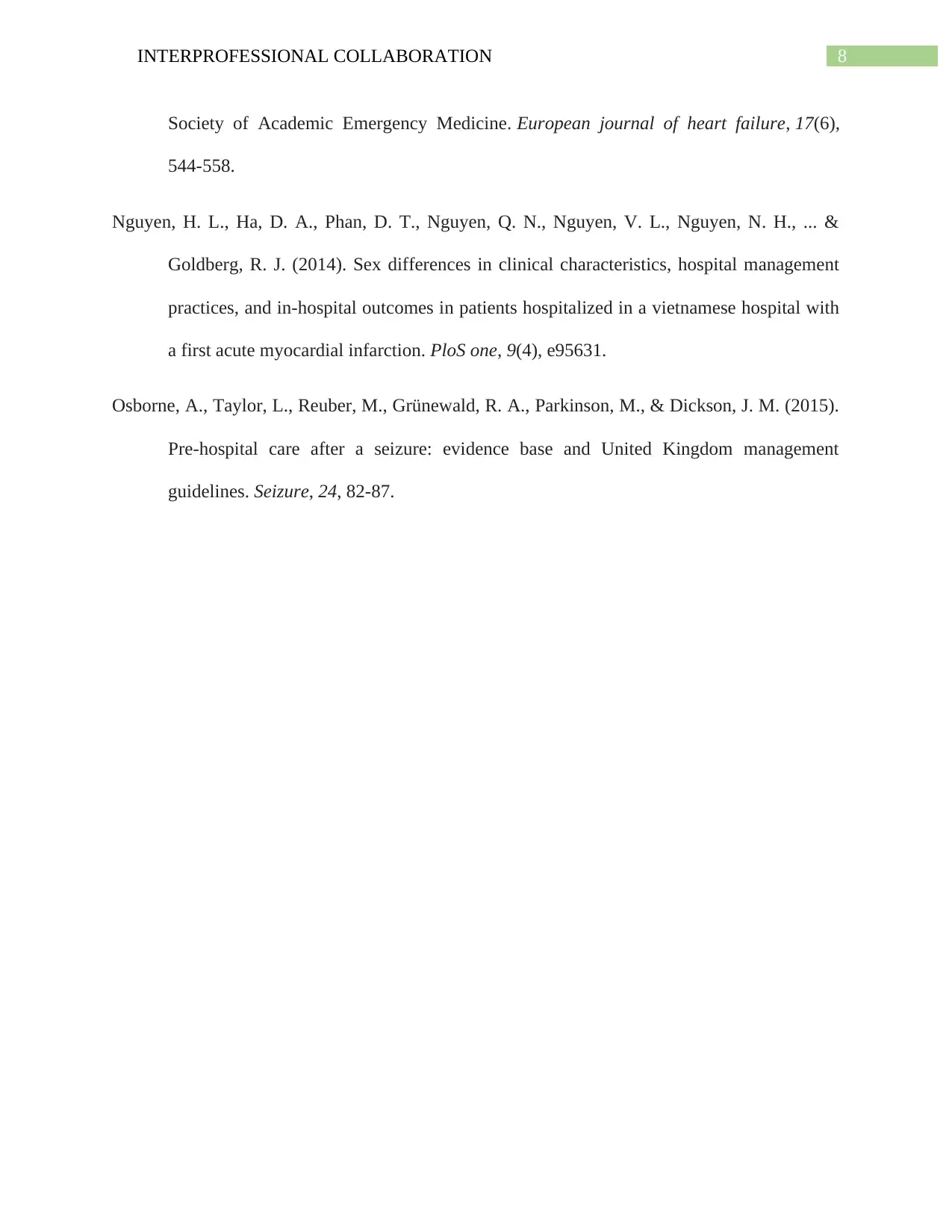
8INTERPROFESSIONAL COLLABORATION
Society of Academic Emergency Medicine. European journal of heart failure, 17(6),
544-558.
Nguyen, H. L., Ha, D. A., Phan, D. T., Nguyen, Q. N., Nguyen, V. L., Nguyen, N. H., ... &
Goldberg, R. J. (2014). Sex differences in clinical characteristics, hospital management
practices, and in-hospital outcomes in patients hospitalized in a vietnamese hospital with
a first acute myocardial infarction. PloS one, 9(4), e95631.
Osborne, A., Taylor, L., Reuber, M., Grünewald, R. A., Parkinson, M., & Dickson, J. M. (2015).
Pre-hospital care after a seizure: evidence base and United Kingdom management
guidelines. Seizure, 24, 82-87.
Society of Academic Emergency Medicine. European journal of heart failure, 17(6),
544-558.
Nguyen, H. L., Ha, D. A., Phan, D. T., Nguyen, Q. N., Nguyen, V. L., Nguyen, N. H., ... &
Goldberg, R. J. (2014). Sex differences in clinical characteristics, hospital management
practices, and in-hospital outcomes in patients hospitalized in a vietnamese hospital with
a first acute myocardial infarction. PloS one, 9(4), e95631.
Osborne, A., Taylor, L., Reuber, M., Grünewald, R. A., Parkinson, M., & Dickson, J. M. (2015).
Pre-hospital care after a seizure: evidence base and United Kingdom management
guidelines. Seizure, 24, 82-87.
1 out of 9
Related Documents
Your All-in-One AI-Powered Toolkit for Academic Success.
+13062052269
info@desklib.com
Available 24*7 on WhatsApp / Email
![[object Object]](/_next/static/media/star-bottom.7253800d.svg)
Unlock your academic potential
© 2024 | Zucol Services PVT LTD | All rights reserved.




